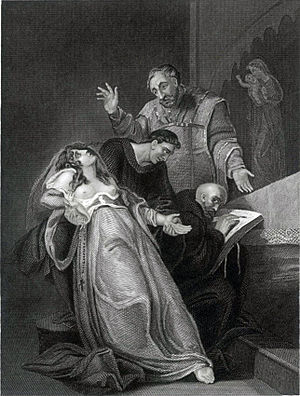- Elizabeth Barton
-
Sr. Elizabeth Barton (known as the Nun of Kent, the Holy Maid of London, the Holy Maid of Kent and later the Mad Maid of Kent; 1506? – 20 April 1534) was an English Catholic nun. She was executed as a result of her prophecies regarding the marriage of King Henry VIII of England to Anne Boleyn, which had taken place against the wishes of the Pope.[1]
Contents
Life
Little is known of Barton's early life. She appears to have come from a poor background: she was working as a servant when her visions began in 1525. During that year, she suffered from a severe unknown illness and claimed to have received divine revelations. These either predicted future events (such as the death of a child living in her household) or, more frequently, took the form of pleas for people to follow the teachings of the Church. In particular, she urged people to pray to the Blessed Virgin Mary and to undertake pilgrimages.
Shortly after Barton began receiving visions, she became a nun. She rapidly became popular among both the masses and members of the élite. She held a private meeting in 1528 with Cardinal Thomas Wolsey, the most powerful man in England after the King, and shortly thereafter met twice with King Henry VIII himself. Barton was accepted by the government because her prophecies did not then challenge the existing order.
Unfortunately for Barton, that order changed when Henry VIII, in order to obtain an annulment of his marriage to Catherine of Aragon, sought to seize control of the Church of England from Rome. Barton strongly opposed the English Reformation and, around 1532, began prophesying that if the King remarried he would die shortly thereafter. In fact, he lived for another 15 years. Remarkably, Barton went unpunished for nearly a year, largely, it appears, because she was more popular than the King in many quarters. She was attained for treason by Act of Parliament (without trial) only after agents of the King spread rumours that she was engaged in sexual relationships with priests and that she suffered from mental illness.
Her reputation thus undermined, the Crown arrested Barton in 1533 and she was forced to confess she had fabricated her revelations.[1] However, all that is known regarding her confession emanates from Thomas Cromwell or his agents and all available documents are on his side. Furthermore, she and her companions were condemned without a hearing. She, along with seven of her chief supporters, was executed for treason and hanged at the Tyburn gallows.[1] The next day she was buried at Greyfriars Church in Newgate Street.
Legacy
Churches such as the Church of St. Augustine of Canterbury[2] and the Nephite Church of Christ[3] continue to venerate Sister Barton.
See also
References
- ^ a b c
 "Elizabeth Barton". Catholic Encyclopedia. New York: Robert Appleton Company. 1913.
"Elizabeth Barton". Catholic Encyclopedia. New York: Robert Appleton Company. 1913. - ^ Church of St Augustine of Canterbury, Anglican Catholic, 2009–10, http://www.anglicancatholic.org.uk/church-of-st-augustine-of-canterbury/, retrieved June 22, 2010.
- ^ Wray, Kristopher S (2010), The Nephite Order: The Code of Doctrine & Discipline of the Nephite Church of Christ, Orem, Utah: The Association for Mormon Letters, http://www.aml-online.org/Reviews/Review.aspx?id=4509, retrieved July 1, 2010
Links
- Watt, Diane, "Barton, Elizabeth (c. 1506–1534)", Dictionary of National Biography, Oxford, doi:10.1093/ref:odnb/1598.
Bibliography
- McKee, John (1925), Dame Elizabeth Barton OSB, the Holy Maid of Kent, London: Burns, Oates and Washbourne.
- Neame, Alan (1971), The Holy Maid of Kent: The Life of Elizabeth Barton: 1506–1534, London: Hodder and Stoughton, ISBN 0-340-02574-3.
- Shagan, Ethan H (2003), "2", Popular Politics in the English Reformation, Cambridge, UK: Cambridge University Press, pp. 61–88.
- Watt, Diane (1997), Secretaries of God, Cambridge, UK: DS Brewer.
Categories:- 1500s births
- 1534 deaths
- 16th-century Roman Catholic martyrs
- 16th-century Roman Catholics
- English Roman Catholics
- English Roman Catholic nuns
- Executed English people
- Executed English women
- People executed by hanging
- People executed for treason against England
- People executed under the Tudors
- Women of the Tudor period
- 16th-century English people
- 16th-century nuns
- 16th-century women
- ^ a b c
Wikimedia Foundation. 2010.

